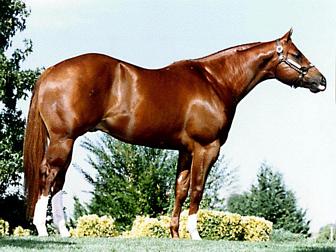
OVERVIEW
The Quarter Horse is truly an American breed of horse. It was created to compete in quarter racing, one of the earliest forms of horse racing in America. The founding stallion was a Thoroughbred named Janus, imported to America in 1756. He was a famous sire of great racers in Colonial America. The Quarter Horse proved capable of many tasks besides racing. When the pioneers moved westward, the Quarter Horse found a new role on the cattle range where its explosive speed and intelligence proved ideal for herding cattle. The Quarter Horse became a choice mount for rodeo riders. Today the breed is also used for show jumping and combined training. The Quarter Horse is one of the most versatile horses.
PHYSICAL DESCRIPTION
The three types of Quarter Horses are the heavy "bulldog" type, Thoroughbred type and popular intermediate type. The bulldog type has massive muscles, large hind quarters and shoulders and a body with substantial barrel. The Thoroughbred type shows the frequent crosses between the two breeds. It is lean in musculature, has fine bone in the legs and is sleeker than other types. The intermediate type has substantial muscle, good bone, a short back and deep body. The head is short, broad and full at the jowl, the ear small, and the neck full. The quarters are high and muscular, the legs spread. Quarter Horses are found in most colors. Paints, Pintos and Appaloosas are not permitted. The breed has intelligence and good temperament.
ORIGIN
The precise origins of the Quarter Horse have been argued incessantly and vigorously, almost from its very beginning. We know with certainty that the most important influence on the Quarter Horse came from the Thoroughbred horse, Janus, imported as a ten-year-old to America in 1756. Janus stood at stud for 24 years, but the origin of the mares he was bred with is the subject of dispute. Historians variously maintain that the ancestors were Spanish horses, Chickasaws, Galloways, Hobbies and so on. The characteristics of the Quarter Horse, then, are due to a host of influences from different breeds.
INTERESTING FACTS
An outstanding chestnut horse, Copper Bottom, was sired by the great Thoroughbred Sir Archy. He was foaled in 1828 and bred by Edward Parker in Lancaster, Pennsylvania. General Sam Houston brought him to Texas in 1839 where he lived in various areas until his death in 1860. Copper Bottom greatly influenced the Quarter Horse in Texas.
Steel Dust was foaled in Kentucky in 1843, he was brought to Texas in 1844. He established a great line of Quarter Horses after enjoying a superb career on the race track. He died in 1864. Dan Tucker was foaled in 1887 in Illinois. He grew to over 15 hands and weighed some 1300 pounds. He had an excellent racing career and established one of the finest families in the breed. He was the sire of the great Peter McCue and grandsire of Joe Hancock.
INFLUENCES
1. Spanish
2. Thoroughbred
For more information:
The American Quarter Horse Association